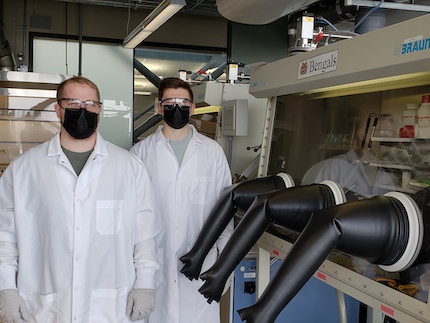Idaho State University Students Leading the Way in Molten Sodium Research for Advanced Nuclear Reactors
February 10, 2022

When developing advanced designs for nuclear reactors, maximizing the transfer of heat provided by nuclear fuel is the name of the game. It’s this transfer of heat that leads to generating electricity, and efficiency is a key element. Now, two Idaho State University students are leading the research charge into how molten metal can get the most out of every ounce of fuel.
“Metals, particularly in liquid form, have proven to be much more efficient at transferring heat than most other media, including water,” said Dr. Dan LaBrier, Assistant Professor in ISU’s Nuclear Engineering Department. “One of the preferred candidates is molten sodium, which was researched extensively at Idaho National Laboratory and its predecessors for more than 40 years.”
The research into liquid metals, including sodium, was put on standby in the mid-1990s. It is now being re-evaluated as an option for the future fleet of nuclear reactors, including a next-generation test reactor - the Versatile Test Reactor. The Versatile Test Reactor is slated to be built at INL or Oak Ridge National Laboratory within the next decade. INL has been identified as the preferred location in an initial analysis performed under the National Environmental Policy Act.
Two student researchers under Dr. LaBrier’s guidance, Jordan Harley and Morgan Robbins, are reviving efforts to perform hands-on experiments using molten sodium. Recently, Harley and Robbins developed, designed, and constructed a custom rig to perform their experiments with molten sodium. Their device takes a solid piece of sodium, heats it until the sodium is a liquid, and allows them to direct the flow of the now-molten sodium onto the material they are experimenting on. Harley and Robbins are trying to determine how molten sodium interacts with insulation for piping. Their results will show them how fast the sodium saturates the insulation and provide a better understanding of leak detection.
“Their project addresses a fundamental safety issue within the nuclear industry related to the interaction of molten sodium and the insulation used to protect the piping of a reactor cooling system,” LaBrier said.
“This research is helping lay the foundation for Generation IV reactors,” said Harley. “Sodium is woven into the fabric of nuclear science’s past, and its thread continues into the future because of its desirable properties.”
“Our research is paving the way for future students at ISU to get involved in sodium experiments and to get hands-on experience in understanding the material,” said Robbins. “I’m excited about this research because it is related to advanced nuclear systems that the global nuclear community is working towards.”
Their experiments are being performed at the Center for Advanced Energy Studies, a research, education and innovation consortium consisting of INL and the public research universities of Idaho.
For more info on the Nuclear Engineering Department, visit isu.edu/ne.
Categories:

